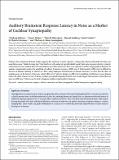| dc.contributor.author | Bharadwaj, Hari M. | |
| dc.contributor.author | Verhulst, Sarah | |
| dc.contributor.author | Mehraei, Golbarg | |
| dc.contributor.author | Hickox, Ann E. | |
| dc.contributor.author | Goldberg, Hannah Rae | |
| dc.contributor.author | Liberman, M Charles | |
| dc.contributor.author | Shinn-Cunningham, Barbara G. | |
| dc.date.accessioned | 2016-11-08T16:43:22Z | |
| dc.date.available | 2016-11-08T16:43:22Z | |
| dc.date.issued | 2016-03 | |
| dc.date.submitted | 2016-02 | |
| dc.identifier.issn | 0270-6474 | |
| dc.identifier.issn | 1529-2401 | |
| dc.identifier.uri | http://hdl.handle.net/1721.1/105258 | |
| dc.description.abstract | Evidence from animal and human studies suggests that moderate acoustic exposure, causing only transient threshold elevation, can nonetheless cause “hidden hearing loss” that interferes with coding of suprathreshold sound. Such noise exposure destroys synaptic connections between cochlear hair cells and auditory nerve fibers; however, there is no clinical test of this synaptopathy in humans. In animals, synaptopathy reduces the amplitude of auditory brainstem response (ABR) wave-I. Unfortunately, ABR wave-I is difficult to measure in humans, limiting its clinical use. Here, using analogous measurements in humans and mice, we show that the effect of masking noise on the latency of the more robust ABR wave-V mirrors changes in ABR wave-I amplitude. Furthermore, in our human cohort, the effect of noise on wave-V latency predicts perceptual temporal sensitivity. Our results suggest that measures of the effects of noise on ABR wave-V latency can be used to diagnose cochlear synaptopathy in humans.
SIGNIFICANCE STATEMENT Although there are suspicions that cochlear synaptopathy affects humans with normal hearing thresholds, no one has yet reported a clinical measure that is a reliable marker of such loss. By combining human and animal data, we demonstrate that the latency of auditory brainstem response wave-V in noise reflects auditory nerve loss. This is the first study of human listeners with normal hearing thresholds that links individual differences observed in behavior and auditory brainstem response timing to cochlear synaptopathy. These results can guide development of a clinical test to reveal this previously unknown form of noise-induced hearing loss in humans. | en_US |
| dc.description.sponsorship | Amelia Peabody Charitable Fund | en_US |
| dc.description.sponsorship | United States. Department of Defense (Office of Assistant Secretary of Defense for Research and Engineering Fellowship) | en_US |
| dc.description.sponsorship | National Institute for Deafness and Other Communication Disorders (U.S.) (Grant T32 DC-00038) | en_US |
| dc.description.sponsorship | National Institute for Deafness and Other Communication Disorders (U.S.) (Grant R01 DC-00188)) | en_US |
| dc.description.sponsorship | National Institute for Deafness and Other Communication Disorders (U.S.) (Grant P30 DC-05029) | en_US |
| dc.language.iso | en_US | |
| dc.publisher | Society for Neuroscience | en_US |
| dc.relation.isversionof | http://dx.doi.org/10.1523/JNEUROSCI.4460-15.2016 | en_US |
| dc.rights | Creative Commons Attribution 4.0 International License | en_US |
| dc.rights.uri | http://creativecommons.org/licenses/by/4.0/ | en_US |
| dc.source | Society for Neuroscience | en_US |
| dc.title | Auditory Brainstem Response Latency in Noise as a Marker of Cochlear Synaptopathy | en_US |
| dc.type | Article | en_US |
| dc.identifier.citation | Mehraei, GGolbarg, Ann E. Hickox, Hari M. Bharadwaj, Hannah Goldberg, Sarah Verhulst, M. Charles Liberman, and Barbara G. Shinn-Cunningham. “Auditory Brainstem Response Latency in Noise as a Marker of Cochlear Synaptopathy.” Journal of Neuroscience 36, no. 13 (March 30, 2016): 3755–3764. | en_US |
| dc.contributor.department | Harvard-MIT Program in Speech and Hearing Bioscience and Technology | en_US |
| dc.contributor.department | Institute for Medical Engineering and Science | en_US |
| dc.contributor.department | Harvard University--MIT Division of Health Sciences and Technology | en_US |
| dc.contributor.mitauthor | Mehraei, Golbarg | |
| dc.contributor.mitauthor | Hickox, Ann E. | |
| dc.contributor.mitauthor | Goldberg, Hannah Rae | |
| dc.contributor.mitauthor | Liberman, M Charles | |
| dc.contributor.mitauthor | Shinn-Cunningham, Barbara G. | |
| dc.relation.journal | Journal of Neuroscience | en_US |
| dc.eprint.version | Final published version | en_US |
| dc.type.uri | http://purl.org/eprint/type/JournalArticle | en_US |
| eprint.status | http://purl.org/eprint/status/PeerReviewed | en_US |
| dspace.orderedauthors | Mehraei, Golbarg; Hickox, Ann E.; Bharadwaj, Hari M.; Goldberg, Hannah; Verhulst, Sarah; Liberman, M. Charles; Shinn-Cunningham, Barbara G. | en_US |
| dspace.embargo.terms | N | en_US |
| dc.identifier.orcid | https://orcid.org/0000-0002-4575-3941 | |
| dc.identifier.orcid | https://orcid.org/0000-0002-5096-5914 | |
| mit.license | PUBLISHER_CC | en_US |
